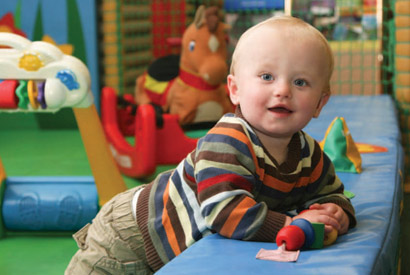Study finds elevated levels of formaldehyde, other contaminants, in day care centers
A study of 40 child-care facilities in California found that most had levels of formaldehyde and a few other contaminants that exceeded exposure guidelines. The study by UC Berkeley researchers is the first to provide a detailed analysis of environmental contaminants and exposures for children in day care centers.

October 25, 2012
A new, comprehensive survey of day care centers by University of California, Berkeley, researchers found that, overall, the environmental quality in child care settings was similar to other indoor environments, but that levels of formaldehyde and several other contaminants exceeded state health guidelines. Cleaning- and sanitizing-related chemicals were also present in the air, and sometimes at higher levels, than in comparable studies on homes.

A new study of 40 California child care facilities found elevated levels of some contaminants, particularly formaldehyde, a respiratory irritant and carcinogen.
The study, funded by the California Air Resources Board (CARB), is the first detailed analysis of environmental contaminants and exposures for California day care centers. It covered 40 early childhood education facilities in Alameda and Monterey counties. Researchers found that 35 of the centers, or 87.5 percent, had levels of formaldehyde greater than 9 micrograms per cubic meters over eight hours, which is above California’s guideline for safe exposure.
Formaldehyde, a known respiratory irritant and a listed carcinogen under California’s Proposition 65, “The Safe Drinking Water and Toxic Enforcement Act of 1986,” is commonly found in the glues used in pressboard furniture and laminated wood. It is also in many paint, clothing and cosmetic products, and is emitted from combustion sources such as wood burning and gas stoves.
“Children are more vulnerable to the health effects of environmental contaminants, and many small children spend as much as 10 hours per day, five days a week, in child care centers,” said study lead author Asa Bradman, associate director of the UC Berkeley Center for Environmental Research and Children’s Health (CERCH). “We wanted to establish the baseline levels of environmental exposures in these early child care settings, and to provide information that could be used for any necessary policy changes.”
The 40 centers in the study were located in a mix of urban, rural and agricultural areas, and served a total of 1,764 children. The researchers collected air and floor dust samples when the children were present and tested for a broad array of chemicals. Particles in the air were also measured, including ultrafine particles, which are extremely small and can be inhaled deeply into lungs.
The California Air Resources Board has been developing and implementing regulatory programs to reduce emissions of volatile organic compounds from consumer products used in homes and institutions. In 2008, under its Toxic Air Contaminants Program, the board implemented new rules to reduce formaldehyde emissions from building materials and furniture made from pressed wood, the biggest source of formaldehyde in indoor air.

Using furniture and products that emit less formaldehyde can help reduce exposure indoors.
Although furnishings and building materials that emit formaldehyde can still be sold in California until the regulation is fully implemented, there are many new pressed wood products on the market that emit little or no formaldehyde. These low emitting products are labeled as CARB Phase 2 (P2). Composite woods products labeled as Ultra Low Emitting Formaldehyde (ULEF) or No Added Formaldehyde (NAF) have the lowest emissions profiles.
Formaldehyde can also form when chemicals from cleaners and sanitizers, such as d-limonene, react with ozone and other compounds in the air. D-limonene is extracted from citrus peels to give cleansers, perfumes and other products a lemon-orange scent.
Ensuring proper ventilation can help reduce contaminant levels, the study authors said.
“These findings show that cleaning and sanitizing products impact air quality in child care settings,” said Victoria Leonard, a scientist at UC San Francisco’s Institute for Health and Aging who is leading a program to promote healthier product choices in child care, and who was not involved in data analysis for this study. “Given that many young children have asthma or other respiratory problems, this study offers strong evidence to select safer cleaning products that have less volatile chemicals.”
In some centers, levels of ultrafine particles increased by up to a thousandfold when cooking appliances were turned on. However, while ultrafine particles have been associated with serious health impacts, their health effects are not well understood, and there are no guidelines for safe levels. And since formaldehyde can also be emitted from gas stoves, the study authors advised using a range hood and fan when cooking to reduce particle and formaldehyde levels.
The researchers also detected other chemicals, including phthalates (found in plastics), flame retardants, pesticides and perfluorinated compounds (found in Teflon and stain resistant carpets).
“For most of those chemicals, however, there has not been adequate toxicity testing, so we cannot evaluate the health risks,” said Bradman.
“This study reinforces the need for child care providers to remain alert to environmental concerns,” said Hester Paul, director of the EcoHealthy Child Care program for the Children’s Environmental Health Network in Washington, D.C.
“It is important to identify areas where improvement is needed, and this study has done that,” added Paul, who is not affiliated with this study. “Fortunately, many local, state and non-profit agencies are working to give child care providers the tools they need to address environmental concerns.”
Other study authors are Fraser Gaspar, Rosemary Castorina, Elodie Tong-Lin and Thomas McKone at UC Berkeley’s School of Public Health, and Randy Maddalena at the Lawrence Berkeley National Laboratory.
RELATED INFORMATION
- ARB-funded study points way to improve indoor air quality in child care facilities (California Air Resources Board press release)
- Air pollution and contaminants at child-care and preschool facilities in California (California Air Resources Board fact sheet)
- Study warns of cleaning product risks (UC Berkeley press release)